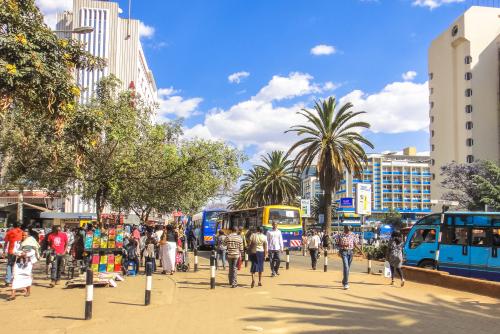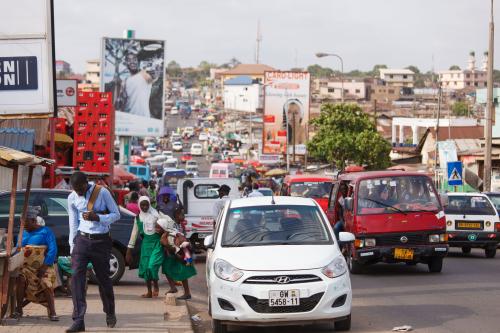Africa’s urban transportation is generally costly, unreliable, and ill-equipped to meet the needs of its population. Inefficient and unsustainable transport networks lead to lower productivity gains and can have a negative impact on the quality of life in cities. Conversely, investments in urban transport not only improve mobility through reduction of greenhouse gas emissions, but also lower transport and commuting costs by increasing connectivity between business and residential areas. As African cities grow, policymakers need to plan for sustainable transport to increase both the livability and productivity of their cities.
The Africa Growth Initiative (AGI) at Brookings has developed a framework that assesses key factors limiting a city’s ability to contribute to the national economic growth. The framework’s ultimate objective is to identify strategies for increasing productive jobs, a central concern in poverty eradication and improving quality of life. As a start, the AGI framework was applied to the city of Nairobi to analyze three primary constraints to its ability to benefit from agglomeration and generate productive jobs: accessibility, the business environment, and public sector governance. This blog focuses on one of the three fundamental aspects that the framework seeks to understand: accessibility and its related elements (such as inter- and intracity accessibility) in enhancing sustainability of urban transportation.
Kenya is home to about 2 million cars and 1.4 million two-wheelers with Nairobi City County accounting for the highest share in the country. Nairobi City County transport is dominated by private cars, matatus (shared taxis), and two-to-three-wheelers (motorbikes and tuk-tuks)—all of which contribute up to 80 percent of total carbon emissions growth each year. Moreover, the country’s carbon emissions have shown a worryingly increasing trend over the last 10 years due to more roads, highways, and car usage. Besides the environmental hazards associated with Nairobi’s current transport system, the city’s current mobility model is also dominated by importation of secondhand fossil-fuel vehicles that require importation of fossil fuels to run them. For instance, Kenya spent over 335.3 billion Kenyan shillings (approximately 2.6 billion U.S. dollars) on petroleum imports in 2021. This attribute is unfavorable on many fronts, including widening the trade/balance of payments deficit and limiting the creation of local manufacturing jobs.
As the number of secondhand fossil-fuel vehicles increases, switching to electric mobility will be an innovative way to build sustainable transport in Nairobi City County. Shifting to electric mobility will also help to reduce the burden of fossil fuels and emissions—essential for better air quality, improved public health, and environmental protection. Furthermore, it will create job opportunities in automotive, electronics, and other supporting industries.
In view of the above, Nairobi City County is laying a strong foundation to support adoption of electric mobility. Kenya is well-endowed with cheap renewable power resources, a key ingredient for electric mobility. Kenya currently generates over 2,700 megawatts (MW) against a demand of 1,860 MW. About 90 percent of the generated electricity comes from renewable sources, which is an improvement from 66.8 percent in 2008. The country’s strategic position near the equator enables ample daily solar exposure of five to seven peak hours that equates to 4-6 kWh/m2/day. Great winds of up to 6 m/s and beyond are also present in specific counties like Samburu, Kajiado, Marsabit, and Laikipia. Despite these favorable conditions, electricity costs in Kenya remain the highest in East Africa partly due to high taxes, inefficiency in transmission, and heavy reliance on fossil fuels in electricity generation.
According to the National Energy Efficiency and Conservation Strategy (2020), Kenya’s target over the five years to 2025, is to expand the percentage of electric vehicle imports from 0 percent to 5 percent of total vehicles imported into Kenya each year (this would translate to increasing the number of imported electric vehicles by 16,000 per year). Kenya also signed the COP26 declaration on accelerating the transition to 100 percent zero-emission cars and vans. In addition, the national government has identified adoption of electric mobility as a priority action for sustainable transportation.
These efforts notwithstanding, Kenya’s electric mobility sector is still in its nascent stages with an estimated 671 electric motor vehicles in total. The sector is also heavily dominated by two-wheelers that account for almost half of the electric vehicles. However, a recent Mckinsey study points to rapidly increasing demand and estimates that Kenya will transition faster than most countries in the region, with electric vehicles accounting for 60 to 75 percent of all two-wheeler sales by 2040.
Nairobi’s electric mobility is promising based on the demand for electric vehicles, as well as the growing number of related innovations and startups in the last few years. These innovations are primarily driven by private actors based in Nairobi, including BasiGo, Kiri, and Opibus. Currently the city hosts more than six assemblers of electric vehicles focusing on two-wheelers; multiple infrastructure providers for charging facilities; and several interested financiers for mobility solutions.
By switching to electric mobility, Nairobi will derive social and economic benefits from decarbonization, inclusive mobility, improved air quality, and local manufacturing of electric vehicles. To accelerate the adoption of electric mobility in Nairobi City County, the following should be considered:
- Promote investment in key infrastructure to support public charging points and servicing of electric mobility.
- Enhance the efficiency and reliability of supply and distribution of electricity through last-mile power connectivity; increase uptake of renewable energies such as solar energy; reconfigure existing thermal power plants to use liquefied natural gas; and adopt smart technologies.
- Increase financing for local electric mobility startups and innovations by tapping global climate change funds and working with climate change champions to promote take-up and a greener economy.
- Provide policy and tax incentives to local assemblers of two-wheelers, auto assemblers, and support adoption of electric buses, minibus taxis, and private cars.
The Brookings Institution is committed to quality, independence, and impact.
We are supported by a diverse array of funders. In line with our values and policies, each Brookings publication represents the sole views of its author(s).







Commentary
Accelerating adoption of electric vehicles for sustainable transport in Nairobi
March 23, 2023